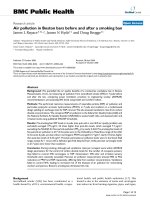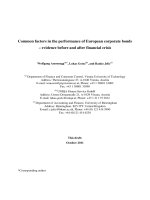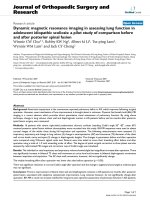Before and after Radical Prostate Surgery pdf
Bạn đang xem bản rút gọn của tài liệu. Xem và tải ngay bản đầy đủ của tài liệu tại đây (860.59 KB, 64 trang )
70762 01-64_trap 10/16/08 4:29 PM KP288CP1935C 1
© 2008 Virginia Vandall-Walker, Katherine Moore, Diane Pyne
Published by AU Press,
Athabasca University
1200, 10011 - 109 Street
Edmonton, AB T5J 3S8
Library and Archives Canada Cataloguing in Publication
Vandall-Walker, Virginia, 1950–
Before and after radical prostate surgery: information and
resource guide / Virginia Vandall-Walker, Katherine Moore,
Diane Pyne.
Issued also in electronic format.
ISBN 978-1-897425-17-6
1. Prostate–Cancer–Surgery–Popular works.
2. Patient education.
I. Moore, Katherine N. (Katherine Nancy), 1946–
II. Pyne, Diane, 1956–
III. Title.
RD587.V35 2008 616.99’463 C2008-905567-5
Printed and bound in Canada by AGMV Marquis
Cover and book design by Alex Chan/Studio Reface
Illustrations by Dwight Allott
This publication is licensed under a Creative Commons
License, see www.creativecommons.org. The text may
be reproduced for non-commercial purposes, provided
credit is given to the original authors.
Please contact AU Press, Athabasca University at
for permission beyond the usage
outlined in the Creative Commons license.
You can order additional copies of this guide online at
www.ubcpress
70762 01-64_trap 10/16/08 4:29 PM P288CK 2
TABLE OF CONTENTS
INTRODUCTION 1
ACKNOWLEDGEMENTS 3
BEFORE SURGERY, AT HOME 5
Who is a Candidate for Radical Prostate Surgery? 6
What is a Radical Prostatectomy? 6
The Types of Procedures Used 7
What Can You Do While Waiting? 12
Suggested Questions for You and Your Partner 16
to Ask Your Urologist
BEFORE SURGERY, IN HOSPITAL 19
The Pre-Admission Clinic 20
THE SURGERY 23
What You Can Expect 24
AFTER SURGERY, IN HOSPITAL 25
When Surgery is Over, Then What? 26
Tips to Help Avoid Problems After Surgery 30
Going Home 32
AFTER SURGERY, AT HOME 35
Care of Your Incision 38
The Catheter 40
Urinary Incontinence 45
Erectile Dysfunction 48
Follow-Up with Your Urologist 49
Back to Work 49
Your Partner/Family 49
CLOSING WORDS 50
RESOURCES 51
YOUR NOTES 57
IMPORTANT TELEPHONE NUMBERS 60
70762 01-64_trap 10/16/08 4:29 PM P288CK 3
70762 01-64_trap 10/16/08 4:29 PM P288CK 4
INTRODUCTION
Prostate cancer affects one in eight Canadian men, primarily
between the ages of 50 and 79. In Canada, over 22,000
new cases are diagnosed every year. Of these men,
approximately 20% will undergo prostate surgery. Before
and After Radical Prostate Surgery provides concise infor-
mation and management tips that will be useful for men
(and their partners) in the hospital and at home, as well as
information about new surgical options for prostate cancer
that are available in some Canadian centres. This guide
is useful as well for those who are still in the process of
decision-making about their treatment choices.
The key sources of information for the authors of this
guide were men who have undergone radical prostate
surgery and some of their partners, as well as health
professionals working with men undergoing prostate
surgery. The participants in our study related the difficul-
ties and challenges they experienced before making the
decision to undergo a radical prostatectomy (RP) as their
treatment choice.
Individuals who shared their prostate surgery experi-
ences with us described the importance of support, both
individually and where applicable, as a couple, from family,
friends, health professionals and their local Prostate
Support Group. Men also spoke of the need to be as
healthy and fit as possible before going into surgery.
Additionally, men and their partners discussed the value
of talking openly with each other and with health profes-
sionals about the emotional aspects of dealing with the
diagnosis of cancer, exploring treatment options, and the
surgical and recovery experience. Counseling was found
to be very beneficial by those who experienced it.
70762 01-64_trap 10/16/08 4:29 PM P288CK 5
Because the majority of the men in our study had
partners who also chose to participate, we were able to
include this important perspective. While not everyone
considering or undergoing RP surgery will have a partner
or spouse, many men will have a friend or relative sharing
the journey, who will also find the information in this guide
applicable.
It must be noted that radical prostate surgery is a very
individual experience, not least because hospital and
surgical procedures vary across the country. Your hospital
and your urologist will provide you with the specific
information you need. While we urge readers of this guide
to seek all available resources to meet their information
needs, we suggest that you discuss the information you
find with a health professional involved in your care to
confirm that it is credible and up-to-date.
We trust that you will find our efforts to be beneficial for
you, your partner, and your family.
70762 01-64_trap 10/16/08 4:29 PM P288CK 6
ACKNOWLEDGEMENTS
This book would not have been possible without the
dedication and drive of the men and their partners,
urology nurses, and urologists, who volunteered their
time to this project. AU Press would like to acknowledge
this commitment and sincerely thank these individuals
for their determination to bring this important project
to fruition.
The authors would particularly like to thank:
Athabasca University’s Academic Research Fund
Edmonton Prostate Cancer Support Group
Dr. Eric Estey
Dr. Michael Hobart
This book is endorsed by:
Canadian Prostate Cancer Network/Réseau Canadien du
cancer de la prostate
The Canadian Continence Foundation
Canadian Urological Association
Urology Nurses of Canada.
70762 01-64_trap 10/16/08 4:29 PM P288CK 7
70762 01-64_trap 10/16/08 4:29 PM P288CK 8
5
BEFORE SURGERY, AT HOME
70762 01-64_trap 10/16/08 4:29 PM P288CK 9
6 BEFORE SURGERY, AT HOME
Who is a Candidate for Radical Prostate Surgery?
Men who have prostate cancer are candidates for radical
prostate surgery when the tumour is localized in the
prostate gland and the cancer has not spread beyond
the prostate gland.
What is a Radical Retropubic Prostatectomy?
The prostate gland is one of the organs that secrete a
fluid that mixes with sperm to make semen. This gland lies
deep in the pelvis behind the pubic bone and surrounds
the urethra, which is the tube that carries urine from the
bladder to the penis.
A radical retropubic prostatectomy is surgery to remove
the prostate gland, the seminal vesicles (that produce
fluid for semen), and the part of the urethra that passes
through the prostate. In some cases, lymph nodes in the
area surrounding the prostate gland may also be removed,
as well as one or both of the nerve bundles adjoining the
prostate gland. The decision on how extensive the surgery
should be, which depends on the individual situation, is
determined during surgery. The relevant parts of the body
are identified in the diagram below.
70762 01-64_trap 10/16/08 4:29 PM P288CP1935CK 10
7
The Types of Procedures Used
There are a number of ways to remove the prostate gland.
Some procedures you may have heard about are no
longer performed. It is important to discuss and under-
stand the procedure that your urologist will be using for
your own surgery. This guide focuses on three procedures
for performing a radical retropubic prostatectomy, which
is the complete removal of the prostate gland through an
incision or incisions made in the abdomen to access the
gland lying behind the pubic bone.
1. The “open procedure”
The traditional surgery for prostate cancer is known as
the “open procedure.” A catheter is inserted into the
bladder through the urethra to help stabilize the urethra
during the procedure. The surgeon then opens an
incision 8 to 10 centimetres long in the patient’s abdo-
men from the belly-button to the pubic bone through
which the prostate gland and a small part of the urethra
are then removed. Other adjacent organs may also be
removed. The cut end of the urethra is then sewn to
the neck of the bladder. Drains are placed around the
surgical site and then the incision is closed (see Fig. 1).
2. The laparoscopic procedure
The term “laparoscopy” refers to a surgical technique
in which a lighted viewing instrument with a camera
(laparoscope) is inserted into the lower belly through a
port placed into a small incision made below the navel.
The laparoscope is a long, thin, flexible tube used to
guide the operation. Carbon dioxide (CO
2
) put into the
abdomen through a special needle helps to separate
70762 01-64_trap 10/16/08 4:29 PM P288CP1935CK 11
8 BEFORE SURGERY, AT HOME
the organs inside the abdominal cavity from the
abdominal wall, making it easier for the surgeon to see
and remove the prostate gland. This gas is removed at
the end of the procedure. The surgeon then uses four
other incision sites, usually no longer than 5 millimetres,
for the introduction of instruments to cut and remove
the prostate gland. This procedure is frequently referred
to as the “lap procedure” (see Fig. 2).
3. The robotic laparoscopic procedure
The third procedure used for radical retropubic
prostatectomy is referred to as the “robotic lap.”
The operation uses the same techniques and incision
sites as described for a “lap”; however, the surgeon
performs the technique by controlling a robot, called
the “Da Vinci Robot.” Both the robot and the procedure
are frequently referred to by the term “robo” (see Fig. 2).
Research has demonstrated that all three of these
procedures are equally effective for removing the
prostate gland and surrounding tissues, and for cancer
control. Potential side effects, such as incontinence and
impotence, are the same for all three procedures. It is
important to discuss and understand the method that
your urologist will use for your surgery. No matter which
procedure is chosen, a radical retropubic prostatectomy
may take from 2 to 4 hours to perform using a general
anaesthetic to put you to sleep. The side effects of the
surgery will vary in severity and duration.
70762 01-64_trap 10/16/08 4:29 PM P288CK 12
Fig. 1 “Open” Prostatectomy Incision
Fig. 2 Laparoscopic and “robo”
Prostatectomy Incisions
70762 01-64_trap 10/16/08 4:29 PM P288CK 13
10 BEFORE SURGERY, AT HOME
Feelings Men and their Partners May Have Before Surgery
A diagnosis of prostate cancer is a shock. We want to
reassure you that some of these feelings and mood swings
are to be expected.
We encourage you to share your feelings and concerns
with your partner and family. They may very well have the
same feelings but were afraid to discuss them because they
didn’t want to worry you. On the other hand, well-meaning
family members and friends might try to convince you that
you should have a different therapy, or none at all. Listen,
but make it clear that the decision is yours to make.
Different people can provide you with different levels and
types of support. Be sure to discuss your feelings with your
urologist, urology nurse, or your family physician. Your local
Prostate Cancer Support Group can offer information and
an opportunity to talk to men and their partners who have
been through prostate surgery and other treatments. Many
men reported finding counseling very helpful. Most cancer
hospitals have psychologists who are available to you and
your family. As well, the Canadian Prostate Cancer Network
(CPCN) has up-to-date information on support groups
and therapists near you. Call 1-866-810-2726 or visit the
website at www.cpcn.org.
• Disbelief This can’t be!
• Anger (sometimes targeted at a partner) Why me?
How could this happen?
• Betrayal
My body has let me down.
• Fear of the cancer Will it spread? How long do I have
to live?
70762 01-64_trap 10/16/08 4:29 PM P288CK 14
• Fear of surgery What will they find when they open me
up? Will I wake up? Will I regain a sex life?
• Loss of control My “living” is out of my control!
• Uncertainty, confusion Have I made the correct
treatment decision? Should I choose a different one?
• Frustration Waiting even one day for surgery is too
long!
(In most cases, waiting will not affect the outcome of
surgery. Talk to your surgeon about this.)
• Mood swings Is this normal? I can’t help it!
11
70762 01-64_trap 10/16/08 4:29 PM P288CK 15
12 BEFORE SURGERY, AT HOME
What Can You Do While Waiting?
1. Gather Information
Talk to your urologist. Ask questions. A list of possible
questions that you or your partner might have is given
on page 16.
Read! Your local cancer facility will have a library you
can access. This guide includes a list of recommended
reading on the topic.
Search the Internet. Some recommended Canadian
websites are listed at the end of this guide. (Be aware
that some websites are simply advertisements for one
therapy or another.)
Talk about what you have read with your partner,
family, urologist, and other members of your health
care team.
Talk to men who have had prostate surgery.
Attend a Prostate Cancer Support Group meeting
in your area. (Family members or close friends are
welcome.)
2. Adopt a Healthy Diet and Lifestyle
Make extra efforts to eat a healthy diet.
Lose excess weight to help improve your overall health.
If you smoke, quit.
Exercise to help with relaxation, weight loss, and
tension relief, and to influence positive outcomes after
surgery. If you do not now exercise regularly, discuss
an exercise program with your family physician or
nurse, and then carry it out.
70762 01-64_trap 10/16/08 4:29 PM P288CP1935CK 16
13
Relieve stress by doing things that help you to relax,
such as listening to music, having a massage, medi-
tating, or finding opportunities for laughter.
3. Take a Break
Take a break from your routine, if you can, such as
a vacation.
Check with your urologist about your plans to ensure
you don’t miss appointments.
4. Collect a Few Items for the Recovery Period
Men who have undergone prostate surgery suggest that
the following items are useful to have for after your surgery.
Loose fitting trousers or sweat pants for comfort over
your abdomen
A comfortable chair (e.g., a recliner)
A soft pillow to make sitting on any chair more
comfortable
Men’s incontinence pads (After surgery, most men
have some loss of bladder control.)
A few protective pads for the bed, chair, and seat of
the car. (Not all men need these.)
Look in the Yellow Pages under “Health Care Supplies.”
At the store, ask for samples so you can choose the
product that is best for you. There are many styles of
pads good for different amounts of urine loss.
See the Canadian Continence Foundation’s resource
guide at
70762 01-64_trap 10/16/08 4:29 PM P288CK 17
14 BEFORE SURGERY, AT HOME
5. Practice Pelvic Floor Exercises (see next page)
Following surgery, you may have trouble controlling
your urine.
The layers of pelvic muscles are like a hammock that
helps support your bladder and bowel to prevent
leakage of urine and stool. Exercising these muscles
may help with urine control after surgery.
It is best to start practicing these exercises before
your surgery.
70762 01-64_trap 10/16/08 4:29 PM P288CK 18
Pelvic Floor Muscle Exercises
You may do the exercises sitting, standing, or
lying down.
Imagine you are trying to stop yourself from
passing gas by squeezing the muscle around your
anus. You should feel the anus muscle move while
the buttocks, thighs, and stomach stay relaxed
(without moving).
If you are doing the exercise correctly, you
should be able to feel, and if you look, to see, the
base of your penis twitch and contract inwards.
cSQUEEZE firmly for 5 to 10 seconds.
cRELAX for 10 to 20 seconds.
cREPEAT the contractions 12 to 20 times.
cDo the exercises 3 times a day.
The exercises are easy. If you find it difficult to
isolate find the right muscles, a physiotherapist
or nurse who specializes in these exercises can
explain how to do them correctly. Ask your health
professional for information about who provides
this service in your area. The nearest Prostate
Cancer Support Group may have audiovisual
materials in various formats to help you learn
how to do these exercises.
15
70762 01-64_trap 10/16/08 4:29 PM P288CK 19
16
Suggested Questions for You and Your Partner to Ask
Your Urologist
Remember, it is your body. You want to be as informed as
you can be.
r What is my PSA? What does this mean?
r What is my Gleason Score? What does this mean?
r What is my “risk stratification”? What does this mean?
r What is the approximate weight of my prostate gland in
ounces? What does this mean?
r Where is the tumor located in my prostate gland? What
does this mean?
r Should I donate my own blood before surgery?
r What type of prostate surgery do you usually perform?
r How often do you do this surgery?
r How many hours will I be at the Pre-Admission Clinic?
r How long will I be in hospital after the surgery?
r What can I expect about bladder control after surgery?
r How does the surgery affect erections and sexual
activity?
r Can you tell me more about the nerve sparing
procedure?
r Could you direct me to resources and professionals
I can speak to for more information about the procedure?
70762 01-64_trap 10/16/08 4:29 PM P288CP1935CK 20
You or your partner may have other questions.
r
r
r
r
r
r
r
r
r
r
r
r
r
r
r
r
r
70762 01-64_trap 10/16/08 4:29 PM P288CK 21
r
r
r
r
r
r
r
r
r
r
r
r
r
r
r
r
r
r
70762 01-64_trap 10/16/08 4:29 PM P288CK 22
19
BEFORE SURGERY, IN HOSPITAL
70762 01-64_trap 10/16/08 4:29 PM P288CK 23
20 BEFORE SURGERY, IN HOSPITAL
The Pre-Admission Clinic
Before surgery, personnel from the hospital where you
will be having your surgery will call to schedule a time to
attend the Pre-Admission Clinic. The timing of the informa-
tion session before the actual date of your surgery can
vary greatly. Prepare for the clinic by reading and talking
to health professionals beforehand, as the Pre-Admission
Clinic is a very busy time.
We recommend that you bring a family member or friend
with you. He or she can help you to remember all the
information the clinic staff will provide. At the clinic,
you will be told about your specific surgery. Physicians
(anaesthetists, residents) and nurses will also ask you for
certain information about your health. If you have diabetes,
your family physician or urologist may have to change your
treatment before your surgery. For example, if you take
insulin, you may need to see a diabetic specialist before
your surgery.
As any medication can influence what tests you may
require, the nurses and physicians will need to know all
of the medications you take. For example, ASA (aspirin)
and other blood thinners may need to be stopped a week
before surgery.
70762 01-64_trap 10/16/08 4:29 PM P288CP1935CK 24
21
Please make a list of the following information and
take it with you to the Pre-Admission Clinic.
r Cigarettes (packs per day)
r Alcohol (drinks per day)
r Herbal medicines (name, dosage)
r Non-prescription medications (name, dosage)
r Prescription medicines (name, dosage)
70762 01-64_trap 10/16/08 4:29 PM P288CK 25









